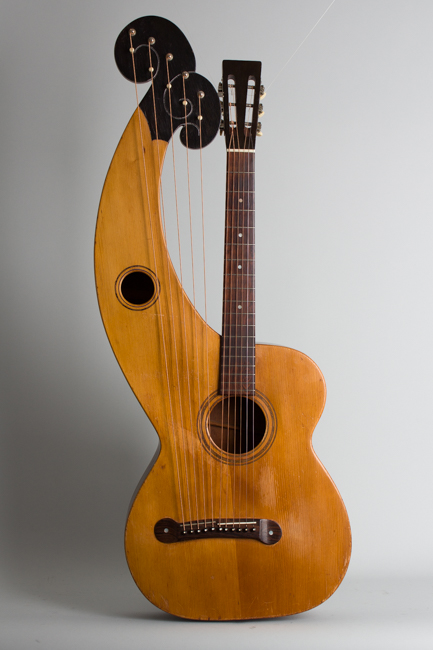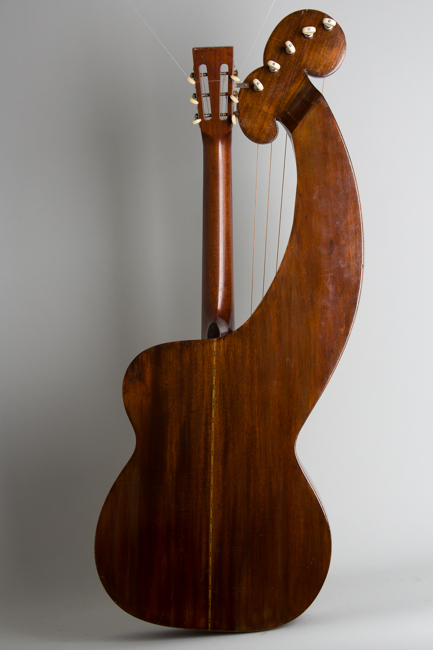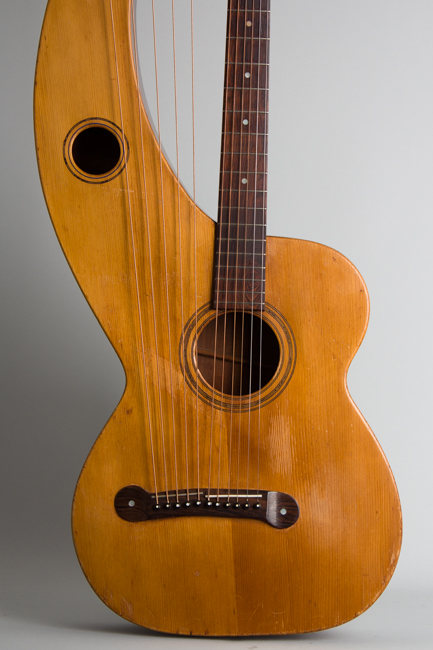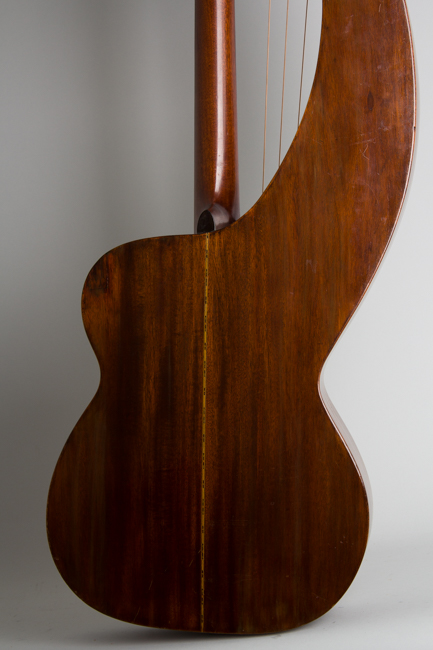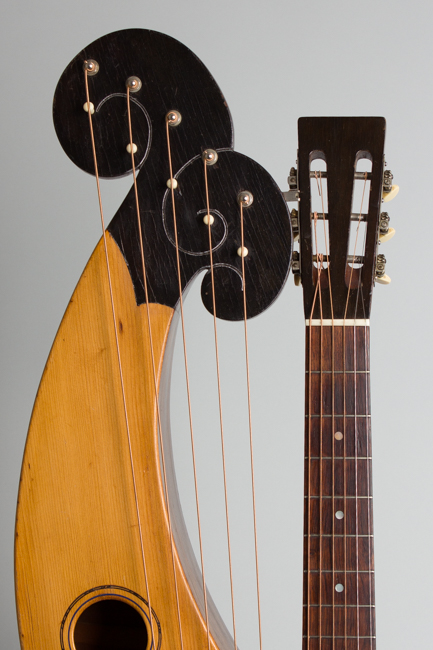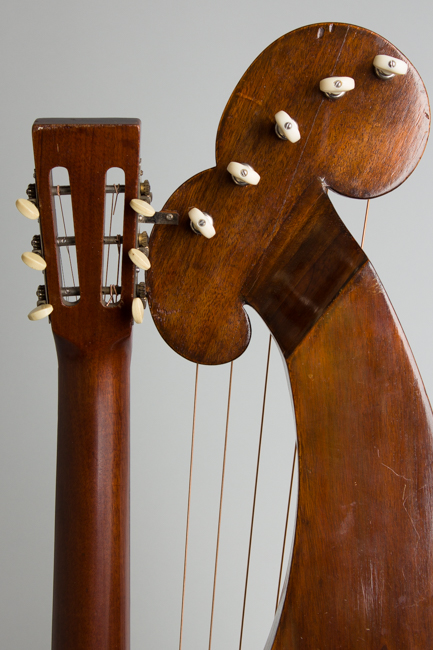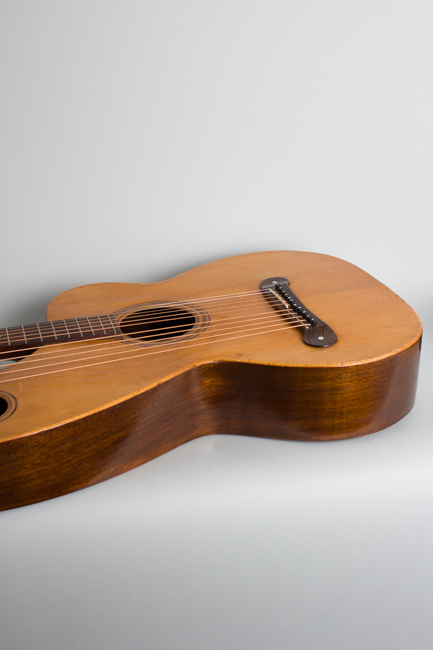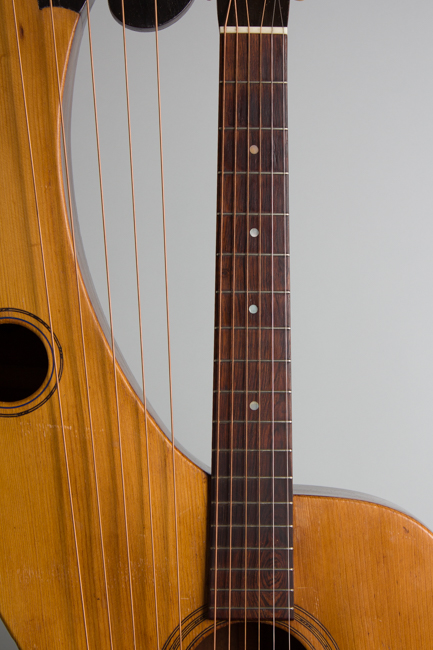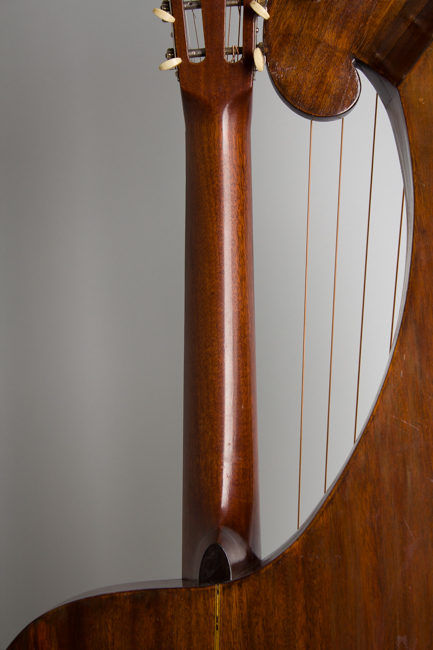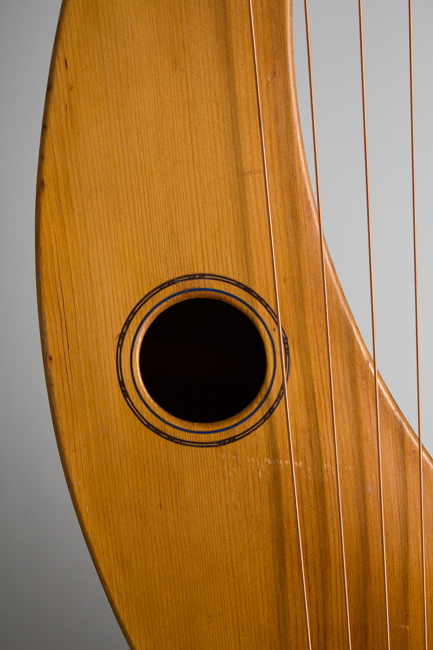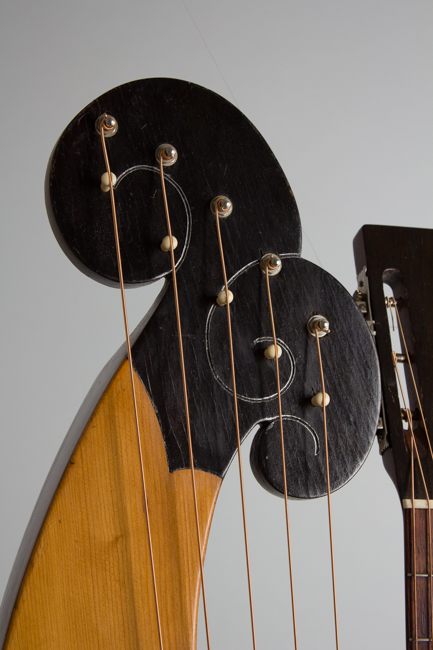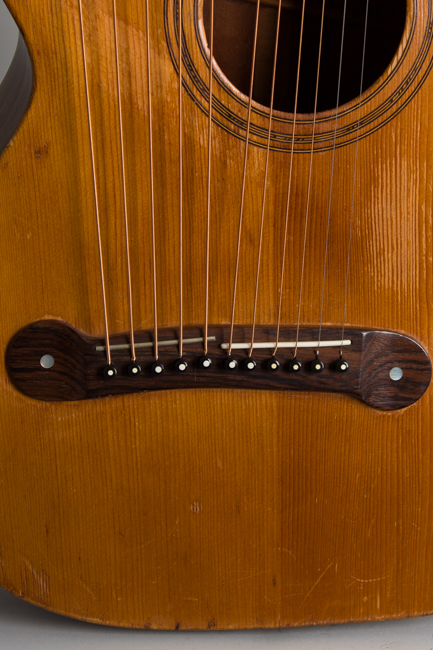Dyer Symphony #4 Harp Guitar, made by Larson Brothers , c. 1910
This item has been sold.
Item # 10695
Prices subject to change without notice.
Dyer Symphony #4 Model Harp Guitar, made by Larson Brothers, c. 1910, made in Chicago, natural finish, mahogany back and sides, spruce top, mahogany neck.
The fantastic-looking (and sounding!) Symphony Harp guitars are one of the most renowned of the Larson Brothers' many fretted creations, made exclusively for W.J. Dyer & Bro of St. Paul in the first decades of the 20th century. These Dyer Harp guitars are considered among most harp guitar enthusiasts as the best of their kind ever made, and many modern luthiers currently use them as a pattern. Since their re-discovery in the 1980s by Michael Hedges and his followers, the Dyer Symphony Harp Guitar has been generally considered the de facto standard design for guitars with sub-bass strings.
A whole line of guitar and mandolin family instruments were marketed by Dyer before the First World War, based on the design patents of Chris Knutsen but after the first few years actually built by the Larson Brothers in Chicago. The guitars were the first to be offered from around the early aught years of the last century, and by far the most successful. This "Style 4" is the lowest model in the line and has a mahogany body and neck and a spruce top with no binding or ornament except a simple inlaid wood sound hole ring.
All "Dyer Symphony" instruments feature a large sweeping hollow upper body extension; on the guitars this serves to hold the banjo-style tuners for the sub-bass string array. Even if these strings are ignored, the extended body with a larger air cavity definitely enhances the instrument's tonal character, giving a depth and airiness unusual in a flat-top guitar of any design. Actually, flat-top is a bit of a misnomer -- while not carved like the Gibsons, the Dyer guitars are "built under tension" with a subtle but noticeable arch to the top and back.
This Style #4 has some wear and repair but remains a very fine-sounding instrument, with a different character from both the heavy carved Gibsons and the typical double-neck flat-top German-style harp guitars of the period. It as some old repairs and appears to have been much played over the last century. Despite a production history spanning a couple of decades, there are only a limited number of these Symphony Harp guitars in existence, and even this plainest example is a masterpiece of both style and sound.
Overall length is 42 1/2 in. (108 cm.), 15 3/4 in. (40 cm.) wide at lower bout, and 4 3/8 in. (11.1 cm.) in depth at side, taken at the end block. Scale length is 25 1/2 in. (648 mm.). Width of nut is 1 7/8 in. (48 mm.).
This 110 or so year old Dyer is a good player's example showing some wear and notable repair but is still a fully intact and quite playable piece of fretted art. The top finish is well worn in a number of spots but original overall with no major overfinish. There are dings, dents and scrapes overall with the most significant wear being areas down to the wood near the soundhole and under some strings, where someone picked hard quite a bit. The back and sides have been overfinished, probably in a French Polish long ago.
There are no cracks on the top, sides or back of the instrument. There is a small square mahogany patch to the back on the turn of the upper treble bout, done well and not very conspicuous. There appears to be a long diagonal grain split in the back of the harp peghead which does not go through to the face. These repairs were likely the reason for the finish work, which as with many instruments done long ago was more extensive than needed.
The Larson's original X-bracing bracing inside the instrument is all original and free from damage. Two support braces have been added near the sound hole to stabilize the top, and some small braces near the upper secondary soundhole. There some distortion to the plane of the top mostly around the main soundhole but the top has been stabilized and is now very solid. Other than these additions the interior remains original and free from any major repair work.
The guitar has had a well done neck set and there is plenty of room on the saddle for future adjustments. The oddly shaped bridge is a well made repro of the original, with slots for bone saddles instead of the single long wire saddle originally used. The six string saddle has been slightly angled in a modern style to allow for better intonation. The guitar retains its original frets and the neck is very straight and easy to play.
The six string headstock mounts very nice period engraved-plate Handel strip tuners, appropriate though they may not be original to the instrument. The harp string tuners have been replaced with modern geared banjo tuners, as these are much more reliable than the original non-geared tuners. Overall this is not the cleanest original of Dyer harp instrument we have had, but it is one of the best sounding and a fantastic player. Very Good + Condition.
The fantastic-looking (and sounding!) Symphony Harp guitars are one of the most renowned of the Larson Brothers' many fretted creations, made exclusively for W.J. Dyer & Bro of St. Paul in the first decades of the 20th century. These Dyer Harp guitars are considered among most harp guitar enthusiasts as the best of their kind ever made, and many modern luthiers currently use them as a pattern. Since their re-discovery in the 1980s by Michael Hedges and his followers, the Dyer Symphony Harp Guitar has been generally considered the de facto standard design for guitars with sub-bass strings.
A whole line of guitar and mandolin family instruments were marketed by Dyer before the First World War, based on the design patents of Chris Knutsen but after the first few years actually built by the Larson Brothers in Chicago. The guitars were the first to be offered from around the early aught years of the last century, and by far the most successful. This "Style 4" is the lowest model in the line and has a mahogany body and neck and a spruce top with no binding or ornament except a simple inlaid wood sound hole ring.
All "Dyer Symphony" instruments feature a large sweeping hollow upper body extension; on the guitars this serves to hold the banjo-style tuners for the sub-bass string array. Even if these strings are ignored, the extended body with a larger air cavity definitely enhances the instrument's tonal character, giving a depth and airiness unusual in a flat-top guitar of any design. Actually, flat-top is a bit of a misnomer -- while not carved like the Gibsons, the Dyer guitars are "built under tension" with a subtle but noticeable arch to the top and back.
This Style #4 has some wear and repair but remains a very fine-sounding instrument, with a different character from both the heavy carved Gibsons and the typical double-neck flat-top German-style harp guitars of the period. It as some old repairs and appears to have been much played over the last century. Despite a production history spanning a couple of decades, there are only a limited number of these Symphony Harp guitars in existence, and even this plainest example is a masterpiece of both style and sound.
Overall length is 42 1/2 in. (108 cm.), 15 3/4 in. (40 cm.) wide at lower bout, and 4 3/8 in. (11.1 cm.) in depth at side, taken at the end block. Scale length is 25 1/2 in. (648 mm.). Width of nut is 1 7/8 in. (48 mm.).
This 110 or so year old Dyer is a good player's example showing some wear and notable repair but is still a fully intact and quite playable piece of fretted art. The top finish is well worn in a number of spots but original overall with no major overfinish. There are dings, dents and scrapes overall with the most significant wear being areas down to the wood near the soundhole and under some strings, where someone picked hard quite a bit. The back and sides have been overfinished, probably in a French Polish long ago.
There are no cracks on the top, sides or back of the instrument. There is a small square mahogany patch to the back on the turn of the upper treble bout, done well and not very conspicuous. There appears to be a long diagonal grain split in the back of the harp peghead which does not go through to the face. These repairs were likely the reason for the finish work, which as with many instruments done long ago was more extensive than needed.
The Larson's original X-bracing bracing inside the instrument is all original and free from damage. Two support braces have been added near the sound hole to stabilize the top, and some small braces near the upper secondary soundhole. There some distortion to the plane of the top mostly around the main soundhole but the top has been stabilized and is now very solid. Other than these additions the interior remains original and free from any major repair work.
The guitar has had a well done neck set and there is plenty of room on the saddle for future adjustments. The oddly shaped bridge is a well made repro of the original, with slots for bone saddles instead of the single long wire saddle originally used. The six string saddle has been slightly angled in a modern style to allow for better intonation. The guitar retains its original frets and the neck is very straight and easy to play.
The six string headstock mounts very nice period engraved-plate Handel strip tuners, appropriate though they may not be original to the instrument. The harp string tuners have been replaced with modern geared banjo tuners, as these are much more reliable than the original non-geared tuners. Overall this is not the cleanest original of Dyer harp instrument we have had, but it is one of the best sounding and a fantastic player. Very Good + Condition.
